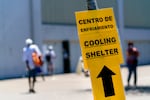
Hundreds have sought shelter at a cooling center at the Oregon Convention Center in Portland, June 28, 2021. The cooling center provided water, snacks, meals, blankets, and cots or mats for sleeping. A large majority of Portland-area people who died in the June heat wave lived without any air conditioning at home.
Kristyna Wentz-Graff / OPB
Multnomah County has released a preliminary analysis of deaths that occurred due to the June heat wave that shattered temperature records across the Pacific Northwest.
One clear early conclusion: Lack of air conditioning was a key driver of the deaths in Portland.
About 80% of Multnomah County residents have some kind of air conditioning at home, according to the report.
Among those who died, most had just a fan to cool their homes. None had central air, and only one person who died had a functioning, plugged-in air conditioner.

Nearly all Multnomah County residents who died in the Northwest's brutal June heat wave lacked air conditioning of any kind.
Courtney Sherwood / OPB
Unusually warm overnight temperatures made it particularly difficult to cool homes and apartments without air conditioning, contributing to the deadly conditions. On the hottest day, Monday, June 28, when temperatures peaked at 116 degrees, the 24-hour average temperature was 96 degrees.
To date, Multnomah County has recorded Oregon’s highest death toll from the heat wave — 54 confirmed hyperthermia deaths and another 17 suspected hyperthermia deaths — according to the state medical examiner.
Prior to the heat wave, the county had reported just two deaths from heat in the past 20 years.
The county had an extreme heat response plan. But it was inadequate given the severity of the heat wave, which climate scientists have described as unprecedented in recorded history.
Related: Oregonians struggled to tap resources during heat wave
“We used every intervention in our plan and several that we improvised in short order,” according to a statement from Jessica Guernsey, the public health director and local public health administrator for Multnomah County, and Dr. Jennifer Vines, the county health officer. “Yet as the deaths recorded here make clear, the devastating effects of climate disruption have arrived much faster than predicted,” the statement continued.
The analysis compiled preliminary information from the death investigations of the 54 confirmed cases of hyperthermia.
Most of those who died were older adults; Their average age was 70. All but four people were identified in preliminary investigations as white, according to the report. Almost all died in their homes, and 78% lived alone.
Of the people whose deaths were reviewed, 55% lived in apartments or another type of multifamily housing.
Related: Oregon wasn’t prepared for the heat wave. Experts say the state can do better
Mobile home park residents were significantly overrepresented among the dead: 10% of the deaths were people living in a mobile home, RV park or vehicle. Mobile-home parks only make up about 1% of the housing units available citywide.
The report confirms that some people died while living in places that are intended to house and care for vulnerable adults, and that are publicly funded. Three hyperthermia deaths occurred in buildings managed by Home Forward, the Portland housing authority. One person died in a building owned by Central City Concern and two died in assisted living facilities.
Home Forward previously acknowledged the three deaths, and said residents in the properties where deaths occurred had access to air conditioning in common rooms.
Two of the people who died were homeless and living in their cars.
The county’s findings could change as toxicology results return and case investigations continue. Officials say further information will be updated when a final report is issued.
